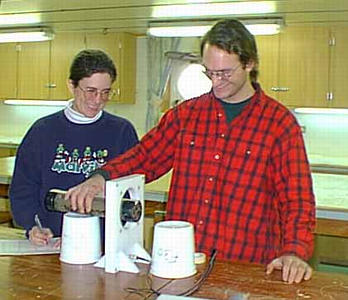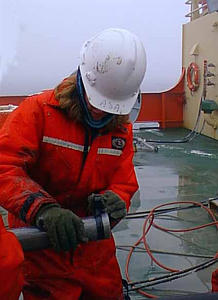19 February, 1999
February 19, 1999
Greetings from the Palmer! We had a nice, sunny day today . . . and it felt
quite a bit warmer than yesterday. Our shift seemed to go very fast, probably
because we were very busy. One of the things that we did was take cores of
the sea floor sediments. What did you decide about yesterday's question? Are
the oldest sediments found at the top or at the bottom of a core? The oldest
sediments are found at the bottom of the core. In the ocean, pieces of debris
slowly drift down through the water and settle on top of the previous
sediments
to make a new layer. Our cores simply penetrate through those sediment layers
and bring a sample of them back to the surface. By studying these sediment
layers, scientists can construct a story about what happened from a long time
ago until very recently.
We have four different ways to get sediments from the ocean floor up to our
ship -- 3 methods of coring and a grab sampler. The grab sampler does just
what it sounds like -- it grabs samples of the sediments, but it doesn't
really
keep them in any kind of order. It brings up about one large bucketful of
sediments at a time. If we are unsure what the sediments are made of, a grab
sampler can give us some sort of indication. If there are too many rocks and
gravel the other corers can break, or the cores will come up empty. So, we
use
a grab sampler to get an indication of what's below us. Sometimes we already
know what the sediments are like, based on previous data and all of our other
equipment. If we don't know, however, a grab sampler is one of those
things to
make sure that we are "better safe than sorry!"
Two of the corers always work together. A piston core and a trigger core are
always taken at the same time. The trigger core is shorter, and when it hits
the bottom it triggers the longer piston core to drop. The trigger core ends
up getting a sample of the upper layer of sediments (less than a meter), and
the piston core gets a deeper sample (4 meters). All of the samples that we
are bringing up contain mud that was under the ice sheet, mud that wasn't
under
the ice sheet, and/or bits of sand and debris.
After we bring the piston and trigger cores back up to the ship, they are
capped at both ends and saved in a walk-in cooler. Our longest piston core
(so
far) is 3 and a half meters long. Both the trigger cores and the piston cores
are 3 inches in diameter. These cores will be shipped back to the U.S. to be
analyzed at a later date. Before we put them in the cooler, we have to
measure
and label them. We want to make sure that they are labeled correctly so that
people will know exactly where and when the core was taken, as well as which
direction is up or down. In addition, we use an instrument called a magnetic
susceptibility meter to determine how easily the sediments react to
magnetism.
Sediments that come from the land react more than sediments that contain a lot
of organic material. We measure the magnetic susceptibility every 5
centimeters.
The other way that we can collect sediments is called a kasten core. It's
larger, like the piston core, but it doesn't need a trigger. In addition, the
barrel that collects the sediments is long and square rather than long and
round. This corer drops to the ocean bottom and gently penetrates down
through
the sediments. Once it is pulled to the surface, the sediments from this core
are analyzed immediately. On one side of the barrel are hinged doors that we
can open to look at the layers of mud and gravel. What types of things do you
suppose we look at when we analyze the core?
Weíll look at that tomorrow. We will be analyzing at least one kasten core
while we are on shift. Other than that, a long seismic line is planned for at
least the next 33 hours. By the 22nd of February, we plan on leaving the Ross
Sea and continuing around the continent into the Amundsen Sea. The sea ice
images look really good right now . . . so we are hoping that we can make this
transit fairly close to the land. As long as the weather is good and the
skies
remain clear, our next location should be very scenic!
Iím really enjoying all of the questions that everyone is sending to me. If
you happen to think of a question, donít hesitate to email me. If you donít
get a response within 24-36 hours, just email it again. Once and a while,
messages seem to disappear between the United States and Antarctica. We donít
have constant Internet communications. We upload and download email about 4
times each day (as long as we arenít facing due south). When you send
email to
me, it really sits on a server in Denver until our ship is able to communicate
via satellite and modem to get the messages. You are also welcome to email me
with suggestions for topics that you would like to see in the journal, as well
as suggestions for photographs to accompany the journals. Hope to hear from
you soon!
Kim Giesting
Latitude: 76 degrees 43 minutes South
Longitude: 164 degrees 38 minutes West
Temperature: -3 degrees C

Kim and Broxton are measuring the magnetic susceptibility of a trigger core.

Ashley is taping a cap on the end of the piston core.

Jay, Ashley, and Dave are washing mud off the outer barrel of the piston core.
Contact the TEA in the field at
.
If you cannot connect through your browser, copy the
TEA's e-mail address in the "To:" line of
your favorite e-mail package.
|
